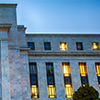Heed the check engine light
ED GOARD, CFA 19-Dec-2011

Thanks to a weakening manufacturing sector and tight—that’s right, tight—monetary policy, the check engine light on the domestic economy has been flashing yellow. Despite recent Federal Reserve actions, fixed income investors would be wise not to ignore the warning and over-reach for yield in this environment.
Trade policy (or lack thereof) has been one key factor that has been applying the brakes to the economy, thanks largely to global leaders in the U.S., China, Great Britain, and Europe who all appear dedicated to their campaigns of maximum unpredictability. As negotiators push to gain any possible advantage, various manufacturing indexes both domestically and globally deteriorated in the third quarter and illustrate that tariffs are now beginning to hit home. The Markit Global Manufacturing Purchasing Managers’ Index (PMI) has been below 50 for several months (any reading under 50 indicates contraction), and the U.S. PMI reading was hovering just above that important level.
The Fed is also partially culpable for not properly fueling the economy. Despite Fed protestations to the contrary, we believe that a flat or inverted yield curve signals overly tight monetary conditions relative to the current economic environment. So while the Fed may be in easing mode (finally), we also believe that it is still paying for overtightening in 2018. It is unlikely that the Fed would have gotten the federal funds rate up to 2.50% absent the fiscal stimulus provided by tax cuts. And let’s not forget that the Fed further tightened monetary conditions via quantitative tightening, or balance sheet reduction, throughout much of 2019.
So the marginal stimulus from tax cuts has now faded, and the Fed has reversed course and joined the global easing trend by cutting interest rates by 0.75% over the past three meetings in July, September and October. Currently, the upper bound for the federal funds target rate stands at 1.75%. Yet we believe the Fed will need to further reduce the federal funds rate upper bound to 1.50% by the end of first quarter of 2020 to avoid recession and extend the recovery. Unfortunately, the Fed has many academics who believe that low unemployment causes inflation despite several years of data to the contrary, thus the risk of the Fed being too stubborn or too slow to cut rates remains a concern.
Another sign of overly tight monetary conditions has been evident in overnight funding rates, which soared in mid-September. Not only did overnight repurchase agreement (repo) rates spiked as high as 10%, but the federal funds rate reached 2.30%, breaking the Fed’s upper bound of 2.25% back in September. Volatility in short-term funding markets forced the Federal Reserve Bank of New York to support the markets for the first time since the Global Financial Crisis, as some banks and/or primary dealers were short of required regulatory reserves (required cash on deposit at the Federal Reserve relative to liabilities). Ultimately, the Fed pumped nearly $200 billion into the overnight lending markets to stabilize interest rates. Although there was a confluence of events that contributed to that spike in rates, the lack of liquidity and volatility was further evidence that quantitative tightening had gone too far.
Indeed, these are challenging times for fixed income investors. Currently, we see the shape of the yield curve as an indicator that monetary policy is excessively tight relative to economic conditions, which in turn creates a heightened risk of recession. We also view the curve as a proxy for risk premium. In a steep curve environment, investors are generally paid well to take on additional risk, but in a flat or inverted curve environment (as we have now), they are not well compensated for adding risk. As a result, we believe that it behooves fixed income investors to remain defensively positioned. In other words, the balance of risks and lack of sufficient risk premium indicates that now is not the time to reach for yield.




